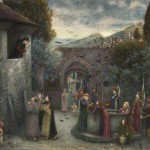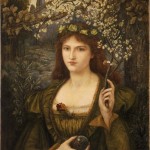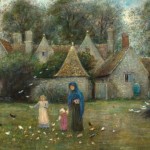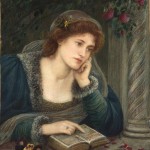Subscribe to Our Newsletter
Marie Spartali Stillman: Renaissance and Renascence
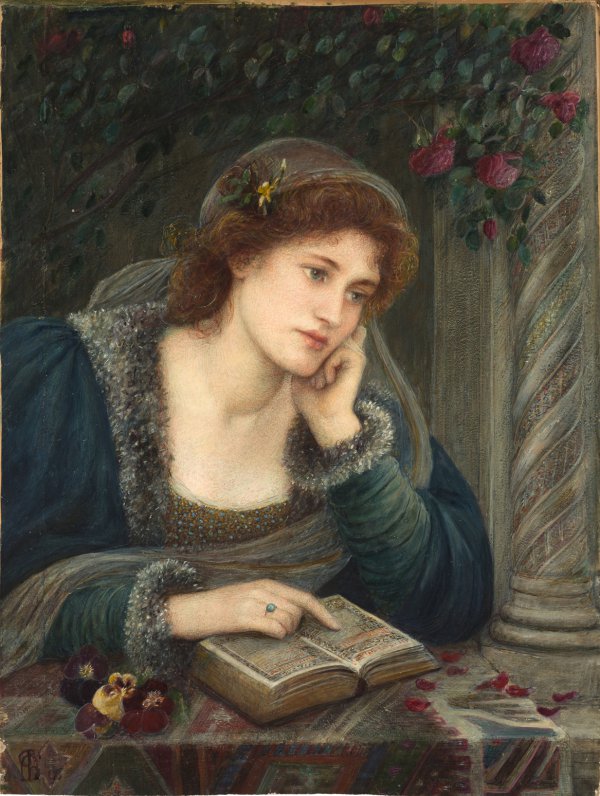
An exhibition at the Delaware Museum of Art rediscovers the art of Marie Spartali Stillman, a Pre-Raphaelite muse turned painter.
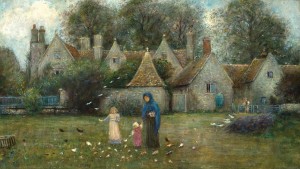
Marie Spartali Stillman, Kelmscott Manor: From the Field, not dated, watercolor and gouache on paper laid on panel, 7 x 12 inches.
Featured Images: (Click to Enlarge)
- Marie Spartali Stillman, The Pilgrim Folk, 1914, watercolor and gouache on paper, 22 x 28 inches.
- Marie Spartali Stillman, Madonna Pietra degli Scrovigni, 1884, watercolor and gouache on paper, 31 x 24 inches;
- Marie Spartali Stillman, Kelmscott Manor: From the Field, not dated, watercolor and gouache on paper laid on panel, 7 x 12 inches.
- Marie Spartali Stillman, Beatrice, 1896, watercolor and gouache on paper, 23 x 17 inches;
When Algernon Charles Swinburne met Marie Spartali, the decadent poet was uncharacteristically at a loss for words. “She is so beautiful I feel as if I could sit down and cry,” was all he could come out with. That sort of reaction was typical for Spartali, who was nearly six feet tall with Classical features and long, thick brown hair. She and her sister Christina, the daughters of Michael Spartali, a wealthy Greek-born businessman and Consul-General of Greece in London, cut a broad swath though the city’s artistic and literary salons of the 1860s. Thomas Armstrong, an artist, met the two young women at a Sunday get-together at their parents’ house in 1863 and recalled, “We were all à genoux before them, and of course every one of us burned with a desire to try to paint them.”
One of Armstrong’s companions that day, James A. McNeill Whistler, got his wish. On other occasions, Marie sat for the photographer Julia Margaret Cameron—exhausting, because Cameron required complex poses and absolute immobility for long stretches of time—and modeled for Dante Gabriel Rossetti, who recast her in a 14th-century Italianate mold in his Vision of Fiammetta and Dante’s Dream. However, not content to be the recipient of gazes, male or otherwise, Spartali began studying painting with Ford Madox Brown, the eldest member of the Pre-Raphaelite circle (he also painted her), and before long she was making significant contributions to the Pre-Raphaelite movement herself.
Marie Spartali Stillman, as she is known to art history (she married American journalist William Stillman in 1871, over the objections of her parents), is still less familiar to the public than many lesser artists of the era. That is in large part due to Spartali Stillman’s own choice not to pursue a professional career with maximum vigor, according to Margaretta Frederick, curator of a major monographic exhibition, “Poetry in Beauty: The Pre-Raphaelite Art of Marie Spartali Stillman,” which runs November 7–January 31 at the Delaware Museum of Art. “She abhorred publicity,” says Frederick. “She never wanted to put herself forward, because she was suspicious of critics and publicity.” She was also a victim of the Victorian mentality that dictated that a woman should not compete with men, or at least not appear to do so. Frederick explains that even Spartali Stillman’s choice of medium—watercolor—was guided by this code of conduct: “In a middle- to upper-middle-class family, women painted in watercolor. So she was fixated on this medium that allowed her to situate herself next to the men and compete on their level without transgressing too many social barriers.”
Not that Spartali Stillman labored in obscurity. She exhibited at the Royal Academy starting in 1870 and had dealers selling her work on both sides of the Atlantic. Her paintings, at first, tracked very closely with what the Pre-Raphaelites had been doing and with the neo-medievalism of William Morris and his circle, among whom she had many friends. Her Beatrice (1896) is typically Pre-Raphaelite, a red-haired beauty in rich fur-trimmed garments, surrounded by roses, her finger pointing to a line in a book that looks like it could have been printed by the Kelmscott Press (Spartali Stillman actually painted Morris’ Kelmscott Manor on several occasions). However, this Beatrice is not the otherworldly, unapproachable demi-goddess of Dante Alighieri and Dante Rossetti, existing only to be pined after; the tender expression in her eyes suggests that she has feelings of her own. In Madonna Pietra degli Scrovigni (1884), Spartali Stillman goes into a fantastical mode. With one hand holding a crystal ball and the other suspending a branch full of mysteriously glowing flowers above her head, this Madonna looks more like a woodland-dwelling sorceress than like the mother of God. After moving to Italy when her husband became the New York Times’ bureau chief in Rome, Spartali Stillman absorbed even more Italian influence into her work. She continued to be fascinated by the Early Renaissance and found rich material in Rome and Florence, but she was also drawn very strongly to the Tuscan landscape, which she painted often.
Putting together the current exhibition was not easy. According to Frederick, about half of Spartali Stillman’s body of work is missing or unaccounted for. And most of what is extant is in private collections. With nine works in its collection, the Delaware Museum actually has the largest public holding of Spartali Stillman in the world. Many of the works in the Delaware show are on loan from the artist’s relatives or those of her husband, most of whom live in the U.S.
Frederick hopes that the show will give Spartali Stillman the attention she deserves, not only as a figure from history, a member of a circle, but as an artist in her own right. “It’s amazing the way female artists get written out of things,” she says. Referring to Rossetti’s famous painting of Fiammetta, the beloved of the Florentine poet Boccaccio, Frederick points out, “Spartali Stillman is best known because she sat for Rossetti’s Fiammetta. But she did a version of Fiammetta first! Then she sat for Rossetti and he painted her in a red dress, and within a year or two she did another version, in a red dress. They wrote some letters to each other about working on Fiammetta. It’s just fascinating. There was a real mutual respect between these artists.”

